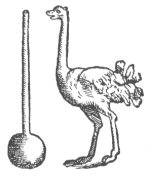Perpetuum Mobile - Concepts III
Chemical Perpetua Mobilia
The previous chapters have concentrated on concepts of physical perpetual
motion devices. This chapter gives a brief overview on alchemistic and chemical
perpetua mobilia. A perpetual motion device needs not neccessarily a rotating
wheel or an electric circuit. Occasionaly, we find legends and reports of
objects which fulfil the typical property of perpetual motion machines: they
generate energy out of nothing. The oldest reports are those of eternal lamps.
Some alchemistic recipes and concepts also are close akin to perpetual motion.
The alchemy is, according to today's knowledge, considerably older than the
first known plans and ideas for perpetual motion machines.
Magnet Stones and Eternal Lamps
Pliny the Elder (23 or 24-79A.D.) described in his natural encyclopaedia
Historia Naturalis the magnet stone and his effects. For us, a remark
considering a temple is interesting. There, a iron statue should be kept
freely floating in a niche by the forces of magnet stones. Although this
is no perpetual motion machine, it was regarded to be physically impossible
until recent times when the floating magnetic gyroscope was inventend. cf.
the magnet section of this site.
"Magnete lapide architectus Timochares Alexandriae Arsinoes templum
concamarare incohaverat, ut in eo simulacrum e ferro pendere in aëre
videretur. intercessit ipsius mors et Ptolemaei regis, qui id sorori suae
iusserat fieri." Lib. XXXIV.148
Pliny Internet editon
"The architect Timochares had begun to use lodestone for constructing the
vaulting in the Temple of Arsinoe at Alexandria, so that the iron statue
contained in it might have the appearance of being suspended in mid air;
but the project was interrupted by his own death and that of King Ptolemy
who had ordered the work to be done in honour of his sister." (transl. by
Rackham)1) |
More interesting are Pliny's considerations on the 'adamas' (i.e. most probably
diamond2) which can amplify or diminuish
the force of magnets. Unwillingly, he laid the foundation for some
physical-alchemistic perpetual motion concepts.
"adamas dissidet cum magnete in tantum, ut iuxta positus ferrum non patiatur
abstrahi aut, si admotus magnes adprehenderit, rapiat atque auferat. adamas
et venena vincit atque inrita facit et lymphationes abigit metusque vanos
expellit a mente." Lib. XXXVII.61
Pliny Internet edition
"The 'adamas' has so strong an aversion to the magnet that when it is placed
close to the iron it prevents the iron from being attracted away from itself.
Or again, if the magnet is moved towards the iron and seizes it, the 'adamas'
snatches the iron and takes it away." (transl. by
Rackham)1) |
Pliny busily collected knowledge and compiled it in his books, but not everything
that was reported by him, proved to be correct. Some of his remarks are
surprising, as they could have easily been proved or disproved by simple
experiments. Those who are interested in details, should have a closer look
into the internet edition of
Pliny's natural
encyclopaedia.1).
Trithemius (1.2.1462-13.12.1516), who is also important for the history of
cryptology, described several eternal lamps. The legend of the opening of
Cicero's daughter Tullia's grave is known. It is said that a lamp has been
found which seemed to be burning since Tullia's burial. When the tomb was
openend, the lamp ceased to work and could not be lit again.
A good overview about ever-burning lamps is given by the internet web site
http://www.levity.com/alchemy/everbrn.html.
John Wilkins dedicated a large chapter of his
Mathematical Magick on eternal lamps
and explanations how they might have worked. Centuries after these pages
have been written, they are still relevant for this topic.
F. Ozanam, a 19th century theologist, (not to be confused with the
Récréationes mathematiques' author), wrote eight pages
about ever-burning lamps.
The major question which arises is, how much of these reports is legend and
how much is in the range of the possible. The follow-up question should be:
what allows the assumption that the found lamps were lit since their supposed
start of use? Was there any opprtunity for fraud?
A few theories might reasonably explain why these lamps could have worked
for a long period of time. The idea is that lamps of this type were mounted
at a fixed location and made use of a natural reservoir of oil or gas. The
fueling by a combustible medium plausibly explains the long-lasting operation.
After being removed, these lamps of course could not be lit again. In contrast
to a perpetual motion device, this type of invention is feasible and works
almost eternally - for human time. However, this is no generation of energy
out of nothing.
The lack of evidence for these lamps imposes a problem, as (as far as I know)
none of the found lamps have been passed into our times. So finally, the
eternal lamp legends are the only thing which is eternally repeated.
Paracelsus
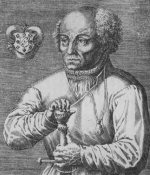 Philipp Aureolus Theophrastus Bombastus von Hohenheim
(10.Nov.1493-24.Sep.1541), better known as Paracelsus, caused quite
an uproar in conventional medicine at his time, as he openly opposed many
old quackeries and introduced chemical methods into the therapy of deseases.
To acertain extent, he can be regarded as father of modern pharmaceutical
methods. However, Paracelsus was not only the modernist as his today's followers
want to see him. In fact, he has grown up in the enviroment of alchemy and
was closely tied to alchemistic tradition.
Cf. Latz: Die
Alchemie pp.984-992.
Philipp Aureolus Theophrastus Bombastus von Hohenheim
(10.Nov.1493-24.Sep.1541), better known as Paracelsus, caused quite
an uproar in conventional medicine at his time, as he openly opposed many
old quackeries and introduced chemical methods into the therapy of deseases.
To acertain extent, he can be regarded as father of modern pharmaceutical
methods. However, Paracelsus was not only the modernist as his today's followers
want to see him. In fact, he has grown up in the enviroment of alchemy and
was closely tied to alchemistic tradition.
Cf. Latz: Die
Alchemie pp.984-992.
John Wilkins (1614-1672) reproduces in his book
Mathematical Magick p.228 an alchemistic
receipe, which is attributed to Paracelsus. Cf. also Ichak,
Das Perpetuum Mobile, p.40.
"Mix five ounces of
 (Mercury)
with an equal weight of (Mercury)
with an equal weight of
 (Tin);
grind them together with ten ounces of sublimate; dissolve them in a Cellar
upon some marble for the space of four dayes, till they become like oyl-olive;
distil this with fire of chaff, or driving fire, and it will sublime into
a dry substance: and so, by repeating of these dissolvings and distillings,
there will be at length produced divers small atomes which, being put into
a glass well luted and kept dry, will have a perpetual motion." (Tin);
grind them together with ten ounces of sublimate; dissolve them in a Cellar
upon some marble for the space of four dayes, till they become like oyl-olive;
distil this with fire of chaff, or driving fire, and it will sublime into
a dry substance: and so, by repeating of these dissolvings and distillings,
there will be at length produced divers small atomes which, being put into
a glass well luted and kept dry, will have a perpetual motion." |
Wilkins immediately adds his disclaimer: "I cannot say any thing from experience
against this; but methinks it does not seem very probable, because these
things that are forced up to such a vigorousness and activity, as these
ingredients seem to be by their frequent sublimatings and distillings, are
not likely to be of any duration; the more any thing is stretched beyond
its usual nature, the less does it last, violence and perpetuity being no
companions." (Mathematical Magick, pp.228-229)
According to Ichak and other authors, this recipe cannot be found in Paracelsus'
treatises. Many texts, which are said to be written by him, have other authors.
A request to the Swiss
Paracelsus-Project
gave the same result.
The Alchimistic Tradition
It is a good idea to have a glance at the alchemistic tradition and its methods.
What was the aim of alchemistic work? What did they search? The classical
answer might be: the philosophers' stone, also being called lapis
philosophorum. But weren't those alchemists simply fraudulent gold makers?
The whole story is not that simple.
Let's exclude all fraudulent guys who claimed, either because of profile
neurosis or of greed for fame, to be able to produce gold out of non-precious
metals. Often enough they found out too late that they ventured a very dangerous
business, which frequently ended in the laboratory of a noble man, his dungeon
or his gallows.
Let's also exclude the cranks and dreamers who believed to be able by buying
alchemistic recipes to find the lapis and being rid of all monetary problems.
They became easy victims of smart adepts who used the direct method
to get gold out of their business. Today, it is not easy to decide which
portion of the remaining alchemists were crackpots and dreamers as well,
but on higher level. And there were a few, who seriously contributed to the
progress of chemical science.
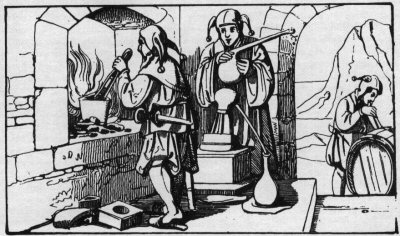
Sebastin Brant (1457-1521) comments in his Narrenschiff (ship
of fools) the alchemists' work:
Damit ich nicht vergessen hibey,
Den grossen Bschiss der Alchemey,
Die macht das Sylber, Golt uffgahn,
Das vor ist in das Säcklin gtan.
|
|
I shall not forget here-by
the big cheat of alchemey
It makes silver, gold upcome
that previously into the purse was
done3) |
|
Let's concentrate on those, who worked in the alchemistic tradition in order
to find out of nature and its secrets. It is inherent to alchemistic work,
that all texts and recipes are cryptic and given in an allegoric way, obviously
to keep ignorant persons off the secrects. The style and language in which
the alchemistic texts are written, gives room for many different interpretations
about the way how methods and chemical reactions are to be performed. The
important point is that results of alchemistic work are not caused by the
method alone, but also depend from the circumstances at which they were
performed, especially astronomical or astrological conditions and the adept's
mind set. According to the ambition of the goal, an appropriate purity of
mind had to be achieved. Thus the generation of the lapis only was
the obvious result, as with the ongoing alchemistic process, not only the
material had to be purified, but primarily the adept's mind. Those who were
not of honest mind, would hardly achieve the magnum opus. And those
who had a pure mind, could withstand all seductions the lapis could
provide, as the adept did not need them any more. Here we definitely see
a magic tradition. Besides the material world and its substances, a spiritual
world has to be in close harmony with them to achieve the goal. The magic
ritual is inherent part of the method.
How Alchemy Works
Salomon Trismosins book Splendor Solis which is famous for its
illustrations gives a first impression how the alchemistical process is intended
to work.
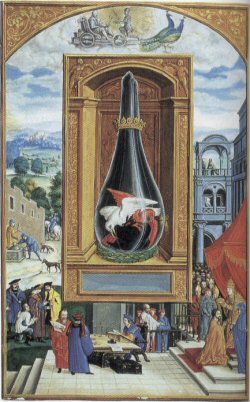
One of the Magnum Opus' steps:
The Phase of multiplication - Multiplicatio
Splendor Solis, ca. 1535
In Splendor Solis the process is shown as a linear sequence of steps.
But methods and steps like destillation or purification (putrefactio)
are not to be understood as single stages, but as repetitive and iterative
steps to remove all undesired remains in the substance. Along with this technical
aspect, by patience, observation, meditation and the use of prayers, but
also by magical formulae, the purification of the adept's mind shall take
place. External circumstances like time of day or night, the constellation
of planets and stars also have influence. This connects the alchemy to the
astrological tradition which states analogies between the celestial sphere
and the fate of men and the world.
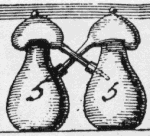 |
| The Circulatorium: repetition as method, allegory
as technology |
|
Remarkable is the repeated usage of process steps which also found its
representation in specialized laboratory apparatus, e.g. the
circulatorium. Besides the pure technology, also mythical analogies
were reason for the shape of devices. Even at 1607, Giovanni Battista della
Porta presented in his book De Destillationibus / Magia Naturalis
an overview of destillation apparatus and their correspondence to the world
of living creatures.4) |
In his Magnes sive De Arte Magnetica
Athanasius Kircher (1601-1680) wrote a lot on magnetic phenomena. He describes
experiments and pastime toys, but he was not immune against magnetic perpetua
mobilia. Suddenly the alchemy shows up, when he writes that the power of
the magnet can be increased by the leaves of the isatis sylvatica.
Similar remarks on diamonds which are said to decrease the magnet's force,
are denied by della Porta, as he experimentally disproved them. When talking
about Kircher, we shall not forget to mention his learned pupil Caspar Schott
(5.Feb.1608-22.May 1666). Schott may not have had Kircher's creativity, but
he was a brave compilator of Kircher's writings and sometimes a somwhat less
critical chronist of progress in physics. In Schott's book Ioco-serium
naturae et artis, sive magiae naturalis centuriae tres (1666) I discovered
this receipe to make an alchemistic perpetuum mobile (p. 139):
PROPOSITIO XXXII.
Mobile perpetuum Alchymisticum
ACcipe amalgamatis
 (aeris)
drachmas v. aut vi. & amal- (aeris)
drachmas v. aut vi. & amal-
gamatis
 (stanni)
tantundem. Tereomnia cum (stanni)
tantundem. Tereomnia cum
 (Mer- (Mer-
curij) sublimati drachmis x. aut xii. & pone supra marmor in
cella. Intra spatium quatuor horarum fiet instar olei oliva-
rum. Hoc distilla, & in fine daignem fortissimum: tunc sub-
limatur substantia sicca. Aqua distillata vicissim reaffunda-
tur in terrae in fundo alembici residuae: & solve quod solvi potest;
solutum filtra, deinde distilla: & apparebunt Subliffimi atomi;
qui in vitro benè clauso in sicco asserventur: Et ecce mirabilia
videbis.
Ex Secretis Kircherianis, uiappellatur mobile perpetuum.
quod hactenus neque per aquam, neque perignem, aut instru-
menta invenieri potuit. Habeturetiam apud Schvventerum in
delicijs par. 16. quaest. 3. ut tradidimus Mechanica
Hydro-pneumatica par. 2. Classe 2.
Machina 14. |
Here we read a purley chemical description. The concluding sentence is
interesting, as it refers to Athanasius Kircher, of whose "secrets" it was
taken. But slow down! Haven't you seen a similar receipe before? If not,
compare this with the apocryph Paracelsus receipe,
wich is discussed in one of the earlier chapters. This probably was so widespread
that it seems like part of the "scientific folklore" of its time, and nobody
asked any more from where it originated or if it was operable at all. But
in this case, it is exactly the same phemomen as can be stated with all
theoretical mechanic PMM constructions of unproven workability.
How close akin alchemy and the search for perpetual motion are, can be seen
in Pierre de Maricourt's remark who thought the magnet stone and the lapis
of the alchemists were the same thing. Other authors followed this idea and
in 1625 P. Mögling wrote in his treatise Perpetuum Mobile, Das ist:
Immerwehrende Bewegung (Perpetuum Mobile, that is: Everlasting
Movement, p. 10):
Es ist aber das in aller Welt so wol be=
schreyte / unnd von unzehlichen in vanum
tentierte PERPETVVM MOBILE, neben
dem Lapide Philofophorum, und Qua-
dratura Circuli, das dritte / nach welchem
alle kunstliebende Gemüther Superioris
& huius Fesuli fo eyfferig getrachtet / und
endlichen fast vor unmöglich gehalten haben. |
|
It is but in all world so praised / and by
countless many in vain tried
PERPETVVM MOBILE, besides
the Lapide Philofophorum, and
squaring the circle, being the third / which
was by all followers of the art earlier
& now tried so tediously / and
eventually have found almost
impossible.3 |
Robert Fludd
Among the alchemists and mystics, Robert Fludd de Fluctibus (1574-1637) is
worth mentioning. In his person, the alchemistic-esotheric component and
the search for technical processes united - in both cases to achieve an
impossible goal. In one of Fludd's books,
Tractatus Secundus de Naturae, we find
a PMM concept. Fludd has not invented this machine himself, but a "certain
Italian". The frequently reproduced image of the Archimedian screw which
can be found in the physics section of this site, originates from a later
time.
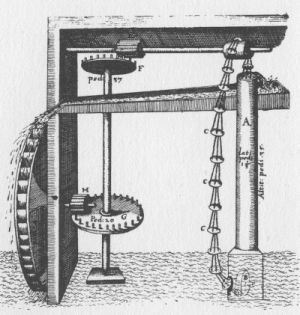
Robert Fludd's recirculation mill
From Tractatus secundus de
naturae..., p.463, 1618
Ichak comments: "Fludd, generally being
convinced of the creation of something out of nothing, thinks the machine
won't work [..] So here, he the alchemist, denies to accept a machine whose
unworkability is evident." (p. 49). Klemm comments Fludd's effort to achieve
eternal motion by man's hands: "[..] observing it sceptically, as it depicts
an eternal recirculation of water inside the
machine."(Perpetuum mobile, p.94).
Fludd himself writes an accompanying text to this contraption which is not
so friendly. He states that the inventor "has wasted time and money with
that aged trash".
Robert Boyle
Robert Boyle (25.Jan.1627-30.Dec.1691) is regarded as a person who caused
great progress in physics and chemics, being one of the first researchers
who fully worked on the basis of the scientific method. Boyle was very wealthy
which gave him the freedom to dedicate himself to his rreaearch work and
to generously support the Royal Society, which at that time thus was rather
a Boyle Society. He became famous by his book The Sceptical
Chymist (1661) and countless scientific articles. Surprisingly,
he published a report in the Philosophical Transactions, in which
he gives a detailled description of a chemical perpetual motion device. Let's
have a look into a short passage:
| "An Ingenious Teacher of Mathematicks, [...] mingled divers Ingredients
in an Earthen Pot, over kindled Coals; but could not, or did not, do it so
warily, but that the matter took fire, and began to blaze furiously; which
obligd him to stifle the flame as hastily as could: and having removed the
Vessel from the fire, and suffered to grow cold; when afterwards ha came
to look upon it, to see if what remained might be of any use to him, he was
surpriz'd to find it variously and briskly moved. Wherefore having set it
aside, to be sure that it might be throughly cold, he after some hours visited
it again, and found it move as before. And having cast store of seeds upon
it, to see if the Liqour would move them also, the Bituminous part of it
connected them into a thick Scum, that covered most of the
Superficies; but left some Intervalls, in which the Liqour appeared,
and discovered that it continued its motions. Two days after, the
Engineer discoursing with me of his Fire work, about which he has
advised with me before; told me, among other things of this odd accident.
And when I asked him, if the motion continued still, and had been answered
affirmatively, tho' it was then a dark night and ill weather, my Diffidence
or my Curiosity made me engage him to send for the Pot as it was; partly
to be sure of the matter of Fact, and partly to try, if the knowledge I had
of the Ingredients, which he had before told me, would afford any hint, of
the cause of so odd an Effect; alike to which in kind, tho' not in degree,
I had many years before devised, and successfully practised, the way of
producing." |
Boyle described precisely how the substance looked like, how it moved and
which experiments he performed. Boyle worked in a systematic way; he checked
if the reaction continued if the substance was barred from fresh air and
observed details. The experiment ends as the pot is accidentially broken
and the strange substance pours onto the ground. The major topic is open:
which substances were used, which mixture was made and how? And thus the
question if Boyle observed an oscillating chemical reaction remains unanswered.
However, there is no doubt that Boyle did not think of a perpetual movement
although the movement lasted for a long time, but weakened after a while.
Here you will find the lengthy original
English text
and a German
translation.
Methodic Science: A Long Way
After Galilei the alchemy slowly lost influence and reputation. The world
of the reproducible scientific experiment left no space for the mental
purification of the researcher in order to successfully achieve results.
Newton was based on alchemistic roots, which frequently is ignored by later
chronists, in order to keep his fame untouched. However, Newton's theory
of gravitation was sceptically regarded by contemporary scientists, as the
remote interaction of masses had a very strong alchemistic smell.
An anonymous author who abbreviated his name with L.v.H. published in 1745
a book entitled Magia Divina oder Grund und deutlicher Unterricht von
den furnehmsten caballistischen Kunststücken. (i.e. Divine Magic
or Distinct Lessons in the Most Noble Caballistic Experiments) Here we
read these instructions:
"Sehe zu daß du in denen zwölff Nächten nach Weihnachten
Dufft von tragbaren Bäumen so viel bekommest, daß es eine halbe
oder gantze Maß Wasser gebe. Dieses hebe wohl verwahret auf. Im Martio
fange auch von tragbaren Bäumen, oder den Früchten im Feld Nebel
Wasser gebe, [...] Hiernach bringe es in zweyten Grad des Feuers, setze
einen Helm darauf und destilliere alles bis auf Honig dicken Safft herüber
und nicht mehr daß es nicht verbrenne, sonsten wäre alles verdorben.
Das überdestillierte rectificiere daß nur eine Maß spirituentes
Wasser bleibe [...] Mercke aber nächst diesem daß, wenn du
das Glaß immer unbewegt stehen läßt, sich ein Dunst in die
Höhe begiebt, welcher einen Schein wie die Sonne von sich geben, und
des Nachts wie der Mond und die Sterne leuchten, auch wie diese 2 Lichter
in der großen Welt ab= und zunehmen wird. [...]"
"See that you get in those twelve nights after Christmas aroma from portable
trees that it give a half or full gallon of water. This keep safely stored.
In March also collect from portable trees or fruits in the fields water given
by fogs,[...] After that, put it in into fire of second degree, put a helmet
onto it and destill all to a honey-thick syrup, but no more in order not
to burn it, or otherwise all is wasted. Rectify the over-destilled that only
one gallon spirituent water remains[...] But notice that, when ever you leave
the glass unmoved, a fog rises into the height which has light like the sun
and at night like the moon and stars, and also will increase and decrease
like these 2 large lights of the
world."3) |
(Ichak, pp. 47-49, abbreviated - cf.
the full German
text)
Again, all elements of the alchemistic tradition can be found in order to
generate a perpetual chemical reaction. Still the magic component is decisive.
The description uses unclear words and meanings and alchemistic-astrologial
conditions as systematic part of the method. These may provide a framework
for the process which is reproducible in method, but not necessarily in results.
Even the physicist David Brewster (11.Dec.1781-10.Feb.1868) had no problems
to publish in the 1818 Chemical Transactions the description of a
magentic perpetual motion device invented by a certain shoemaker Spence.
The machine got its motive force by the use of an unspecified "black substance"
which apparently allowed Spence to diminish or strengthen the magnetic force
as desired. This is the same idea already described by Pliny the Elder -
and still used 1700 years after his death.
The Alchimistic-Perpetual Illusion
According to today's knowledge, the Lapis philosophorum was neither
found nor generated in the past. Is this a proof for flaws in earlier chemical
technology or the fact that purified minds cannot be achieved? Briefly spoken,
the alchemist is exactly in the same situation as the perpetual motion machine
inventor. He knows that only small problems need to be solved, he only needs
some more money, a little more time, or a few special parts and substances
which are currently not available. He might need some more books or other
special literature... He works with optimism, persistence and fanatism, but
the goal is too hard to achieve. If the magnum opus cannot be finished,
always the circumstances are to blame, but never the inventor's incompetence,
ignorance or lack of insight. The inventor finally describes how things should
be according to his ideas, but not how they are according to oberservations
and laws of nature.
This option today is used as frequently as in earlier times. Not only the
inventors of classical perpetul motion machines, but also the advocates of
"free energy" cannot be distinguished from their predecessors. In Europe,
the case of a Swiss enterprise became known, which
successfully
collected money to bring "spaces quantum motors" to series production,
which never left the experimental stage. Even if we assume honest business,
we find that not incompetence made the machines unworkable, but the contradicting
mindset of traditional physics, which makes the failure completely
explained
by magic.
Remarks:
1. I'd like to thank Prof. Thayer,
the editor of the internet Pliny edition, who gave valuable hints and friendly
support in providing the english translation, which was cited from the Loeb
edition by Harris Rackham 1952.
2. adamas is translated here as
diamond. This does not quite catch the meaning, as adamas can
indicate other precious minerals as well.
3. Translation by H.-P. Gramatke
4. Analogies will show up again when we
discuss Johannes Kepler's work. Analogies
can be a very powerful concept, but it needs care to use them
correctly.
| Last update: 22 May 2004 /
|
|
 Philipp Aureolus Theophrastus Bombastus von Hohenheim
(10.Nov.1493-24.Sep.1541), better known as Paracelsus, caused quite
an uproar in conventional medicine at his time, as he openly opposed many
old quackeries and introduced chemical methods into the therapy of deseases.
To acertain extent, he can be regarded as father of modern pharmaceutical
methods. However, Paracelsus was not only the modernist as his today's followers
want to see him. In fact, he has grown up in the enviroment of alchemy and
was closely tied to alchemistic tradition.
Cf. Latz: Die
Alchemie pp.984-992.
Philipp Aureolus Theophrastus Bombastus von Hohenheim
(10.Nov.1493-24.Sep.1541), better known as Paracelsus, caused quite
an uproar in conventional medicine at his time, as he openly opposed many
old quackeries and introduced chemical methods into the therapy of deseases.
To acertain extent, he can be regarded as father of modern pharmaceutical
methods. However, Paracelsus was not only the modernist as his today's followers
want to see him. In fact, he has grown up in the enviroment of alchemy and
was closely tied to alchemistic tradition.
Cf. Latz: Die
Alchemie pp.984-992.





